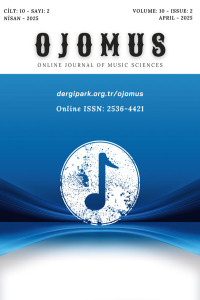Abstract
Bu makale, modern klasik gitar repertuarının önde gelen bestecilerinden Roland Dyens’in iki gitar için bestelediği Niterói adlı eserinin ayrıntılı bir analizini sunmaktadır. Dyens’in iki gitar için yazdığı eserler incelendiğinde, bestecinin yaratıcılığının iki önemli dönemde yoğunlaştığı görülmektedir: 1990’ların başlarında ve 2010 sonrası, hayatının son yıllarında. Bahsedilen ilk dönemde biri konçerto olmak üzere, ConcertOmaggio (Dyens, 1999) ve Côte Nord (Dyens, 1994) gibi eserlerle iki gitar için yazdığı müzikal dilini şekillendiren Dyens, ikinci dönemde bu dilini olgunlaştırarak Comme des Grands (2010) ve Niterói (Dyens, 2012) gibi eserlerle iki gitarın tek bir enstrüman gibi iç içe geçtiği yapılar oluşturmuştur. Çalışmada, Niterói eserinin formu, ritmik ve melodik yapısı ile kullanılan teknikler ayrıntılı bir şekilde incelenmiş; özellikle iki gitarın birleşerek tek bir tını yaratma fikri üzerinde durulmuştur. Dyens’in solo gitar için geliştirdiği müzikal dilini iki gitar konseptine genişleterek enstrümanlar arası etkileşim ve geçişkenliği nasıl kurguladığı ele alınmıştır. Eserin, profesyonel düzeyde gitaristler için ileri seviyede bir pedagojik yaklaşımı temsil ettiği ve ideal bir icra için iki gitaristin tam bir uyum ve senkronizasyon içinde olmalarının zorunlu olduğu sonucuna varılmıştır. Niterói, bu bağlamda, Dyens’in iki gitar için geliştirdiği bestecilik anlayışının olgun bir sentezi olarak değerlendirilebilir ve gitar literatürüne önemli bir katkı sağlamaktadır. Bu analiz, eserin gitar pedagojisi ve performans pratiği açısından önemini ortaya koymayı hedeflemektedir.
References
- Beavers, S. (2006). Homage in the solo guitar music of Roland Dyens [Doctoral dissertation, The Florida State University]. Globe Thesis. https://globethesis.com/?t=1445390005475111
- Birch, M. (2005). Jazz mind and classical hands: Roland Dyens and his style of arranging and performing. Retrieved February 5, 2007, from https://bibliotecadelaguitarra.com/es/articulo/3938/jazz-mind-and-classical-hands-roland-dyens-and-his-style-of-arranging-and-performing.html
- Çoğulu, T. (2009). Interview with Roland Dyens. Andante, 38.
- Dyens, R. (1994). Côte Nord: Éloge de Duo Assad [Guitar score]. Henry Lemoine.
- Dyens, R. (1999). ConcertOmaggio [Orchestral score]. Henry Lemoine.
- Dyens, R. (2010). Comme des Grands [Guitar score]. Les Productions d’Oz.
- Dyens, R. (2011). Niterói [Recorded by ChromaDuo; CD booklet]. Naxos Music. (Original work published 2010). https://cdn.naxosmusiclibrary.com/sharedfiles/booklets/GEC/booklet-8.572757.pdf
- Dyens, R. (2012). Niterói [Guitar score]. Les Productions d’Oz.
- Purple Institute. (2014). A Visit to the Niterói Contemporary Art Museum (Mac) Designed by Oscar Niemeyer, Rio. Purple Diary. Retrieved February 2, 2025, from http://purple.fr/diary/a-visit-to-the-niteroi-contemporary-art-museum-mac-designed-by-oscar-niemeyer-rio/
- Sanders, E. H. (1974). The medieval hocket in practice and theory. The Musical Quarterly, 60(2), 246–256.
- Ünlenen, E. (2025). Masters of the Guitar, Episode 44 [Radio broadcast]. Borusan Klasik.
Abstract
This article presents a detailed analysis of Niterói, a piece composed for two guitars by Roland Dyens, one of the prominent composers in the modern classical guitar repertoire. While Dyens’s overall compositional career was prolific and diverse, his works for guitar duo are relatively few and concentrated in two distinct periods: the early 1990s and after 2010, the years leading up to his death. In his early duo works, such as ConcertOmaggio (Dyens, 1999) which is a concerto, and Côte Nord (Dyens, 1994), Dyens began exploring the possibilities of intertwining two guitars to function as one cohesive instrument. In his later years, he returned to this exploration, culminating in Comme des Grands (2010) and Niterói (Dyens, 2012), which represents a mature synthesis of his compositional ideas for guitar duo. This study delves into the form, rhythmic and melodic structures, and techniques employed within Niterói, placing particular emphasis on the concept of merging two guitars to create a unified timbre. By expanding his musical language, originally conceived for solo guitar, into a duo context, Dyens explores the interplay and fluidity between the instruments. It is concluded that the work represents an advanced pedagogical approach intended for professional guitarists, requiring an ideal performance where both guitarists achieve perfect synchronization and a unified musical understanding. Niterói can be seen as a significant contribution to the guitar duo repertoire, and this analysis aims to highlight its importance in the context of guitar pedagogy and performance practice.
References
- Beavers, S. (2006). Homage in the solo guitar music of Roland Dyens [Doctoral dissertation, The Florida State University]. Globe Thesis. https://globethesis.com/?t=1445390005475111
- Birch, M. (2005). Jazz mind and classical hands: Roland Dyens and his style of arranging and performing. Retrieved February 5, 2007, from https://bibliotecadelaguitarra.com/es/articulo/3938/jazz-mind-and-classical-hands-roland-dyens-and-his-style-of-arranging-and-performing.html
- Çoğulu, T. (2009). Interview with Roland Dyens. Andante, 38.
- Dyens, R. (1994). Côte Nord: Éloge de Duo Assad [Guitar score]. Henry Lemoine.
- Dyens, R. (1999). ConcertOmaggio [Orchestral score]. Henry Lemoine.
- Dyens, R. (2010). Comme des Grands [Guitar score]. Les Productions d’Oz.
- Dyens, R. (2011). Niterói [Recorded by ChromaDuo; CD booklet]. Naxos Music. (Original work published 2010). https://cdn.naxosmusiclibrary.com/sharedfiles/booklets/GEC/booklet-8.572757.pdf
- Dyens, R. (2012). Niterói [Guitar score]. Les Productions d’Oz.
- Purple Institute. (2014). A Visit to the Niterói Contemporary Art Museum (Mac) Designed by Oscar Niemeyer, Rio. Purple Diary. Retrieved February 2, 2025, from http://purple.fr/diary/a-visit-to-the-niteroi-contemporary-art-museum-mac-designed-by-oscar-niemeyer-rio/
- Sanders, E. H. (1974). The medieval hocket in practice and theory. The Musical Quarterly, 60(2), 246–256.
- Ünlenen, E. (2025). Masters of the Guitar, Episode 44 [Radio broadcast]. Borusan Klasik.
Details
| Primary Language | English |
|---|---|
| Subjects | Composition in Western Classical Music, Interpretation in Western Classical Music |
| Journal Section | Research article |
| Authors | |
| Publication Date | April 30, 2025 |
| Submission Date | February 6, 2025 |
| Acceptance Date | February 25, 2025 |
| Published in Issue | Year 2025 Volume: 10 Issue: 2 |


